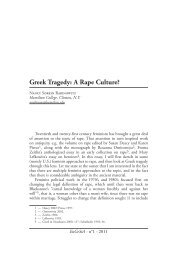Perspectives On and Of Livy's Tarpeia - EuGeStA
Perspectives On and Of Livy's Tarpeia - EuGeStA
Perspectives On and Of Livy's Tarpeia - EuGeStA
You also want an ePaper? Increase the reach of your titles
YUMPU automatically turns print PDFs into web optimized ePapers that Google loves.
194 TaRa WeLCh<br />
herself barren yet a guarantor of fecundity, <strong>and</strong> the like 60 . as Beard<br />
expressed in the second of the two articles, which is a palinode of sorts to<br />
the first, these paradoxes are the point of the priesthood. In the context of<br />
the current exploration, I note that <strong>Tarpeia</strong>’s vestal priesthood renders her<br />
both more Roman, in that she is firmly connected to the fledgling state’s<br />
institutions, <strong>and</strong> less familial, in that she is not to marry <strong>and</strong> no longer<br />
falls under her father’s patria potestas 61 . In this way, describing her as the<br />
daughter of Tarpeius <strong>and</strong> a priestess virgo, Livy again positions <strong>Tarpeia</strong><br />
in between – this time, in between her family <strong>and</strong> the state institution<br />
she serves. she is in between in another way, too; vestals are wards of the<br />
state. The state is her family, so for her those two entities are no longer<br />
distinct.<br />
Gender-wise, too, <strong>Tarpeia</strong> is in between. as a vestal, her ritual chastity<br />
freezes her at a stage between unripe girlhood <strong>and</strong> fulfilled womanhood.<br />
Roller has suggested that, as a virgin (<strong>and</strong> so not a fully realized women<br />
yet), heroic Cloelia arouses less anxiety than she otherwise would have, for<br />
her congress with the etruscan Porsenna is not of such a sort as to allow<br />
him or his people to mingle, blood-wise, with the Romans 62 . Cloelia’s<br />
allegiance has never been in doubt. It seems to me that <strong>Tarpeia</strong>’s virginity<br />
in Livy functions differently from Cloelia’s. <strong>Tarpeia</strong> shows that the<br />
virgin might choose differently, <strong>and</strong> that her virginity is really a place of<br />
exchange. It is fitting that <strong>Tarpeia</strong> is buried by crushing, her body intact.<br />
The shields that cover her are the very weapon designed to protect the<br />
integrity of the fighter’s body. <strong>Tarpeia</strong>’s death is similar to the punishment<br />
meted out to transgressive vestals, who were entombed alive (so as not to<br />
violate them even in their death). But it also forecloses any possibility that<br />
her body would be a point of reconciliation between Roman <strong>and</strong> sabine,<br />
unlike horatia, whose body, pierced by the same sword that had pierced<br />
alban Curiatius, now admitted foreign blood.<br />
Livian <strong>Tarpeia</strong><br />
<strong>Tarpeia</strong>’s refusal to be situated comfortably in any category – traitor or<br />
patriot, Roman or not, self or other, daughter, virgin, or bride – renders<br />
her, in a way, an anti-example. If we are to read <strong>Tarpeia</strong> as an exemplum,<br />
either positive or negative, we must strip her story of its complexities <strong>and</strong><br />
incongruities. valerius Maximus (9.6.1) sanitizes her story in just this<br />
60 — Beard 1980 <strong>and</strong> 1995.<br />
61 — vestals <strong>and</strong> patria potestas: Gellius 1.12.9, <strong>and</strong> see also staples 1998: 141-3 <strong>and</strong> Lorsch<br />
Wildfang 2006: 64-75.<br />
62 — Roller 2004: 39 n. 82 notes that <strong>Tarpeia</strong>, Tullia, <strong>and</strong> Tanaquil reveal tensions between<br />
endogamy <strong>and</strong> exogamy, since their bodies are vehicles for the convergence of bloodlines, whereas<br />
Cloelia’s virginity alleviates some concern. see also Koptev 2005.



